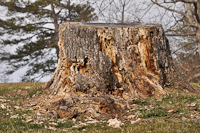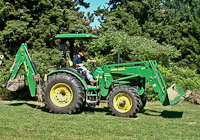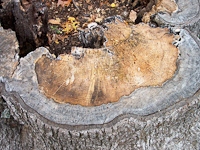|

Cutting down that dead
tree is only the first step in restoring your landscape.
It always leaves a stump behind that must be dealt with
in some way. The options include:
-
Do Nothing - Of
course, you can leave the stump and use it as a
stand for
containers or
statuary. Or, you can just
leave it there as a part of "nature" as it slowly
rots away.
-
 Dig It Out -
Depending on the size of the tree, you might just be
able to dig it out with a shovel. Of course this is
only practical with fairly small trees and shrubs
but it can be quite effective, if back breaking but
free. Dig It Out -
Depending on the size of the tree, you might just be
able to dig it out with a shovel. Of course this is
only practical with fairly small trees and shrubs
but it can be quite effective, if back breaking but
free.
-
Grind It Out - Tree
removal companies usually have a tough little
machine called a stump grinder. These powerful
machines can turn the stump into sawdust in no time.
This is the quickest and surest way to remove the
stump but it also the most expensive.
-
Kill It - Certain
species of trees such as
catalpa,
boxelder,
poplars
and
willows may send up new shoots from the old
stump. They may also send new shoots out of the
ground from the root system. The easiest but most
labor intensive control is to just keep cutting the
new growth down to the ground as soon as it shows
up. Plants produce their own food through
photosynthesis in the leaves. If you deny a plant
leaves for long enough, it must die.
 In rare instances, you could use brush control
herbicides to kill the stump. These need to be
painted onto the freshly cut stump or new shoots.
Follow label instructions for these products. They
tend to be powerful chemicals. In rare instances, you could use brush control
herbicides to kill the stump. These need to be
painted onto the freshly cut stump or new shoots.
Follow label instructions for these products. They
tend to be powerful chemicals.
-
Digest the Stump -
Nature will eventually rot the stump away into its
component elements just like anything else. However,
due to the volume of woody material, this process
will take many, many years. There are commercial
products advertized to hurry this process. For the
most part, they are ineffective and not worth the
effort and cost.
-
Pull the Stump -
Tractors and other heavy duty vehicles are sometimes
used to pull stumps from the ground. This can be
extremely dangerous if you do not know what you are
doing. If the tractor is not big enough or powerful
enough, it might tip over backward and injure or
kill the driver. Four wheel drive vehicles may be
damaged if used incorrectly. Chains can break and
fly away at killer speeds. Get the hint? Be
Careful!!
|



